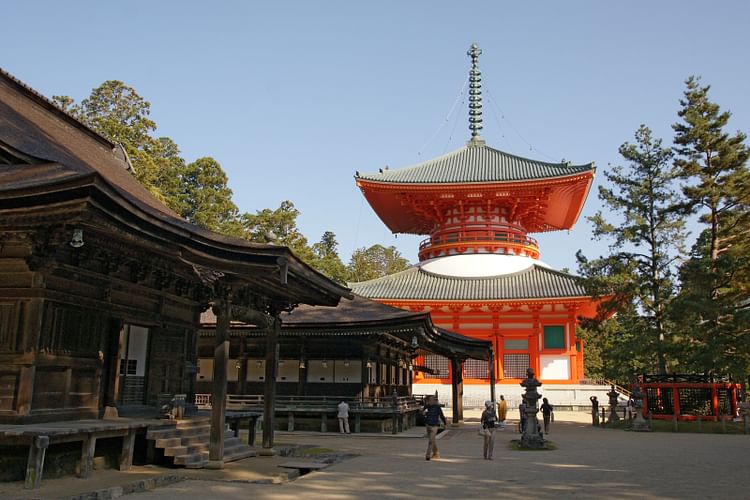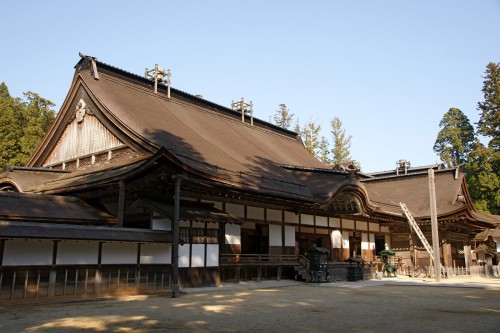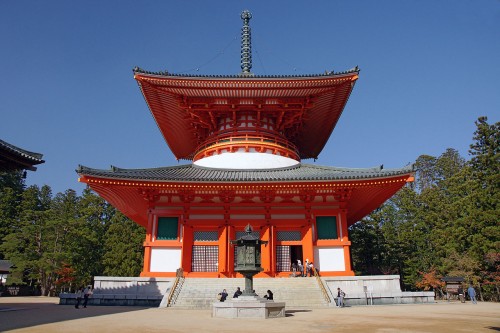Mount Koya › Gojoseon » Ancient origins
Articles and Definitions › Contents
- Mount Koya › Ancient History
- Gojoseon › Ancient History
Ancient civilizations › Historical and archaeological sites
Mount Koya › Ancient History
Definition and Origins

Mount Koya (aka Koyasan), located in the Wakayama Prefecture, south of Osaka, Japan, is the site of a temple complex founded in 819 CE by the scholar monk Kukai as the headquarters for Shingon Buddhism. There are temples and sacred buildings around the base of the mountain, on its slopes and on the top plateau which is 820 metres (2,690 ft) above sea level.Mount Koya is a UNESCO World Heritage Site.
SHINGON BUDDHISM
Kukai (774-835 CE), was a scholar, poet, sculptor, monk, and general miracle worker who founded Shingon Buddhism in Japan. Kukai studied in China under the master Hui-kuo, abbot of the Ching Lung (Green Dragon) Temple and, chosen as the master's successor, was suitably initiated. Thus, he became an advocate of Esoteric Buddhism or mikkyo, which meant that only the initiated, only those who gave up their worldly life and resided in a monastery could know the Buddha and so achieve enlightenment.
MT. KOYA SOON BECAME A POPULAR SITE OF PILGRIMAGE, ALTHOUGH, IT WAS NOT ACCESSIBLE TO WOMEN UNTIL 1872 CE.
The Shingon (or 'True Word') Sect which Kukai studied in China (there known as Quen-yen) had made its way from southern India. It held that Buddhist teachings came from the cosmic Buddha Mahavairocana (Dainichi to the Japanese). Crucially, Shingon Buddhism proposed that an individual could achieve enlightenment in their own lifetime and need not wait for death.Rituals included meditation carried out while the body was held in various postures, sacred hand gestures ( mudras ), and the repetition of secret formulas or mantras. Great importance was given to the power of prayer.
MT. KOYA MONASTERY
In 819 CE Kukai created a centre for his esoteric doctrine on Mount Koya in the modern Wakayama Prefecture, 80 km (50 miles) from the then capital Heiankyo (Kyoto). According to legend, the monk chose the site after meeting a hunter with one white and one black dog on the mountain slopes. This figure was the son of the Shinto kami or spirit of Mt. Koya, and he kindly gave Kukai permission to build his Buddhist temple there in a story which highlights the traditional coexistence between the two religions in ancient Japan. The Shinto goddess is still represented on the mountain by the Niutsushime Jinja at the top and the Niukanshofu shrine at the base.

Kongobu-ji, Mount Koya.
The temple complex is still today the headquarters of the Shingon Buddhist Sect. Here, educated devotees could reach enlightenment, it was promised, not by the lifelong study of sutras but by viewing mandalas, the stylised visual representation of the teachings of Buddha. Not only a base for scholars and monks, Mt. Koya soon became a popular site of pilgrimage, although, it was not accessible to women until 1872 CE.
Kukai also established a route of pilgrimage - the longest and most famous in Japan - which is a 1,600 km (1,000 miles) circuit which stops at 88 temples, many of them built where the monk was said to have performed a miracle. Kukai died in 835 CE - he had predicted the very day - and was buried in a tomb on Mount Koya. In 921 CE Kukai was given the posthumous title of Kobo Daishi meaning 'Great Teacher of Spreading the Law' by the emperor.
ARCHITECTURAL HIGHLIGHTS
The Jison-in pagoda is part of the temple complex at the mountain base and marks the start of the Choishimichi pilgrimage trail which winds up the slopes stopping at various sacred sites along the way. The walk takes 8 hours and follows 180 stone markers where the faithful should stop at pray. Midway up the mountain is the Shinto Niutsushime shrine which has a two-storeyed Offertory building, wooden bridge, carp pond, and a torii or sacred gate.

Daito Pagoda, Mount Koya
At the top of the mountain on a plateau is the site of the original temple built by Kukai. The Danjo Garan precinct has 20 structures which include a memorial hall, three pagodas, and the large Daimon Gate with its Nio guardian statues to ward off evil spirits. The main pagoda here is the Daito Pagoda with its impressive double roof and interior mandalas illustrating Shingon Buddhism. First built in 819 CE, the structure was destroyed by fire but rebuilt in 1937 CE.
The head temple of the mountain, the Kongobu-ji, is next to the Danjo Garan precinct, and here is the Kondo or Main Hall which is a reconstruction dating to 1932 CE. Unlike its predecessors, the building is equipped with two large water buckets on the roof and a permanently placed ladder so as to better fight any outbreak of fire. Here, too, is the largest rock garden in Japan. The mausoleum of Kukai and the Torodo memorial hall is also part of the temple complex and is reached by the Gobyobashi bridge. Across the bridge, in the sacred area of the tomb, visitors are required not to eat, smoke, or use cameras.Other sites of note in the vicinity include two Tokugawa mausoleums, the Okunoin Cemetery with its hundreds of statues of the bodhisattva Jizo, many wearing a red bib for good luck, and the small Kongo Sammai-in monastery.
This article was made possible with generous support from the Great Britain Sasakawa Foundation.
Gojoseon › Ancient History
Definition and Origins

Gojoseon (Gochoson or Old Choson) was an ancient kingdom which ruled northern Korea in the second half of the first millennium BCE. Gojoseon possessed the most advanced culture in the Korean peninsula at that time and was an important marker in the progression towards the more centralised states of later periods.
FOUNDATION
According to Korean mythology, as recounted in the 13th-century CE Samguk yusa ('Memorabilia of the Three Kingdoms'), Gojoseon was founded in 2333 BCE by Dangun Wanggeom (Tangun) who was the offspring of the god Hwanung and a female bear transformed into a woman. This myth may symbolise the arrival of Bronze Age culture in Korea. Dangun was born on the third day of the tenth month, and so today the 3rd of October is celebrated as National Foundation Day in South Korea.The Korean name Choson derives from the Chinese name Chaoxian, itself a combination of the two words chao ('dawn') and xian ('calm' or 'fresh'), hence the referral to Korea on occasion as 'Land of the Morning Calm.'
According to some historians, the state was formed from the alliance of small fortified towns around the Daedong (Taedong) and Liao River basins perhaps from the 7th century BCE and more certainly from the 4th century BCE. The northern boundary of Gojoseon was the Liao River while its immediate southern neighbour was the Jin (Chin) state. An early reference to the Gojoseon state is found in the c. 100 BCE text Records of the Grand Historian written by the Chinese historian Sima Qian.Qian mentions that Gojoseon existed in 190 BCE. However, the only uncontested date for the existence of a state by the name of Choson/Gojoseon is 109 BCE, and historians continue to debate whether it is possible to describe Gojoseon as a state proper, when exactly did it exist, where was its capital, and what were the exact territories under its control. The location of the capital has long been considered as being near Pyongyang, but there is also evidence that it may have been further north in Manchuria.
THE KOREAN NAME CHOSON DERIVES FROM THE CHINESE NAME CHAOXIAN, MEANING 'LAND OF THE MORNING CALM'.
RELATIONS WITH CHINA
Relations between Korea and China go back to mythology when the sage Kija (Jizi) and 5,000 followers left China and settled in Dangun's kingdom. When the latter decided to retreat to meditation on a mountaintop, Kiji was made king of Gojoseon in 1122 BCE. This myth may represent the arrival of Iron Age culture to Korea.
The historical rulers of Gojoseon did adopt the Chinese title wang (king) illustrating an early influence from neighbouring Yan China, probably a trade partner, perhaps, with Gojoseon acting as a middleman between China and the southern states of Korea. Another indicator of trade relations is the discovery of Chinese crescent knife coins ( mingdaoqian ) at various Korean sites.
Chinese culture was likely brought to Korea by refugees fleeing the 4th-century BCE conflicts of the Warring States period.Archaeological evidence of this cultural influence is perhaps best seen in the use of pit burial tombs in the Daedong River area and the frequent presence of horse trappings therein. The tombs are also of interest as several contain over 100 slaves buried with, and presumably belonging to, the occupant. With better iron tools introduced from China, agricultural production increased and so too the general prosperity of Gojoseon. Grey stoneware, which was rich in iron, also first appeared at this time, as did the famous Korean ondol underfloor heating system.

Dangun Wanggeom
COLLAPSE
Gojoseon was weakened by attacks from the neighbouring Yan state c. 300 BCE, and a long decline set in so that when Gojoseon finally collapsed in the 2nd century BCE its territories were taken over by Wiman Joseon (Wiman Choson). This was a state which was led by Weiman, a Chinese refugee (though possibly of Korean origin) who had earlier fled the Yan state. He and his 1,000 followers were given the task of protecting the north-western borders of Gojoseon by king Chun, but Weiman, or Wiman in Korean, took the opportunity to seize control of part of the country himself sometime between 194 and 180 BCE and declared himself king. Chun is said to have fled south to the Jin state where he reigned as king.
Wiman may well have brought elements of Chinese culture to Korea such as Confucianism and Taoism. Wiman Joseon did not last very long and, in 108 BCE, was conquered by the Han dynasty of China (206 BCE – 220 CE) and the capital Wanggom captured. The Han emperor Wu (141-87 BCE) was eager to expand his empire and acquire northern Korea's natural resources, especially iron and salt, and sent an army of 50,000 men and a 7,000-man naval force. Having removed this troublesome southern kingdom, the Han then divided northern Korea into four commanderies directly administered by the Han central government. They would maintain control of this part of the peninsula for the next four centuries. Refugees from the collapsed Wiman Joseon took their culture south, which would eventually rise again and defeat the Chinese in the subsequentThree Kingdoms period. The name Joseon/Choson would also reappear as the name of the state which dominated Korea from the 14th century CE.
This article was made possible with generous support from the British Korean Society.
LICENSE:
Article based on information obtained from these sources:with permission from the Website Ancient History Encyclopedia
Content is available under License Creative Commons: Attribution-NonCommercial-ShareAlike 3.0 Unported. CC-BY-NC-SA License